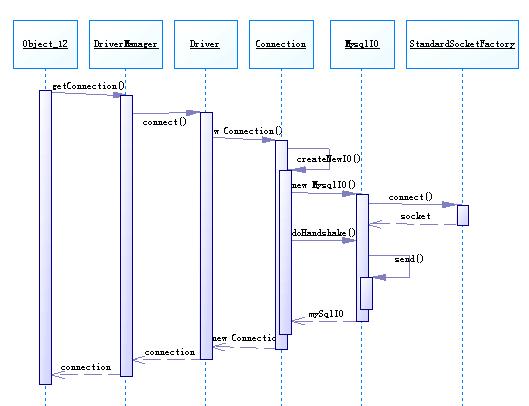从时序图中可以看到,createNewIO()就是新建了一个com.mysql.jdbc.MysqlIO,利用 com.mysql.jdbc.StandardSocketFactory来创建一个socket。然后就由这个mySqlIO来与MySql服务器进行握手(doHandshake()),这个doHandshake主要用来初始化与Mysql server的连接,负责登陆服务器和处理连接错误。在其中会分析所连接的mysql server的版本,根据不同的版本以及是否使用SSL加密数据都有不同的处理方式,并把要传输给数据库server的数据都放在一个叫做packet的 buffer中,调用send()方法往outputStream中写入要发送的数据。

useServerPreparedStmts置为true的话,mysql驱动可以通过PreparedStatement的子类ServerPreparedStatement来实现真正的PreparedStatement的功能
第一位表示数据包的开始位置,就是数据存放的起始位置,一般都设置为0,就是从第一个位置开始。第二和第三个字节标识了这个数据包的大小,注意的是,这个大小是出去标识的4个字节的大小,对于非最后一个数据包来说,这个大小都是一样的,就是splitSize,也就是maxThreeBytes,它的值是 255 * 255 * 255。
最后一个字节中存放的就是数据包的编号了,从0开始递增。
在标识位设置完毕之后,就可以把255 * 255 * 255大小的数据从我们准备好的待发送数据包中copy出来了,注意,前4位已经是标识位了,所以应该从第五个位置开始copy数据
# packetToSend = compressPacket(headerPacket, HEADER_LENGTH,
# splitSize, HEADER_LENGTH);
LoadBalancingConnectionProxy
package java.lang.reflect 。 proxy .
http://developer.51cto.com/art/200907/137823.htm
http://dev.mysql.com/doc/refman/5.1/en/connector-j-reference-implementation-notes.html
PreparedStatements are implemented by the driver, as MySQL
does not have a prepared statement feature. Because of this,
the driver does not implement
getParameterMetaData() or
getMetaData() as it would require the
driver to have a complete SQL parser in the client.
Starting with version 3.1.0 MySQL Connector/J, server-side
prepared statements and binary-encoded result sets are used
when the server supports them.
但这是不是说PreparedStatement没用呢?不是的,PreparedStatement有其他的好处:
1.代码的可读性和可维护性
2.最重要的一点是极大地提高了安全性,可以防止SQL注入
然后我又看了一些网上其他人的经验,基本和我的判断一致,有两点要特别提请大家注意:
1.并不是说PreparedStatement在所有的DB上都不会提高效率,PreparedStatement需要服务器端的支持,比如在
Oracle上就会有显著效果。上面说的测试都是在MySQL上测试的,我找到了一个MySQL架构师的帖子,比较明确地说明了MySQL不支持
PreparedStatement。
2.即便PreparedStatement不能提高性能,在少数使用时甚至会降低效率,但仍然应该使用PreparedStatement!因为其他好
处实在是太大了!当然,当SQL查询比较复杂时,可能PreparedStatement好处会更大,只是我没有测试,不敢肯定。
3.既然PreparedStatement不能提高效率,那PreparedStatement Pool也就没有必要了。但可以看到每次新建Connection的开销实在很大,因此Connection Pool绝对必要。